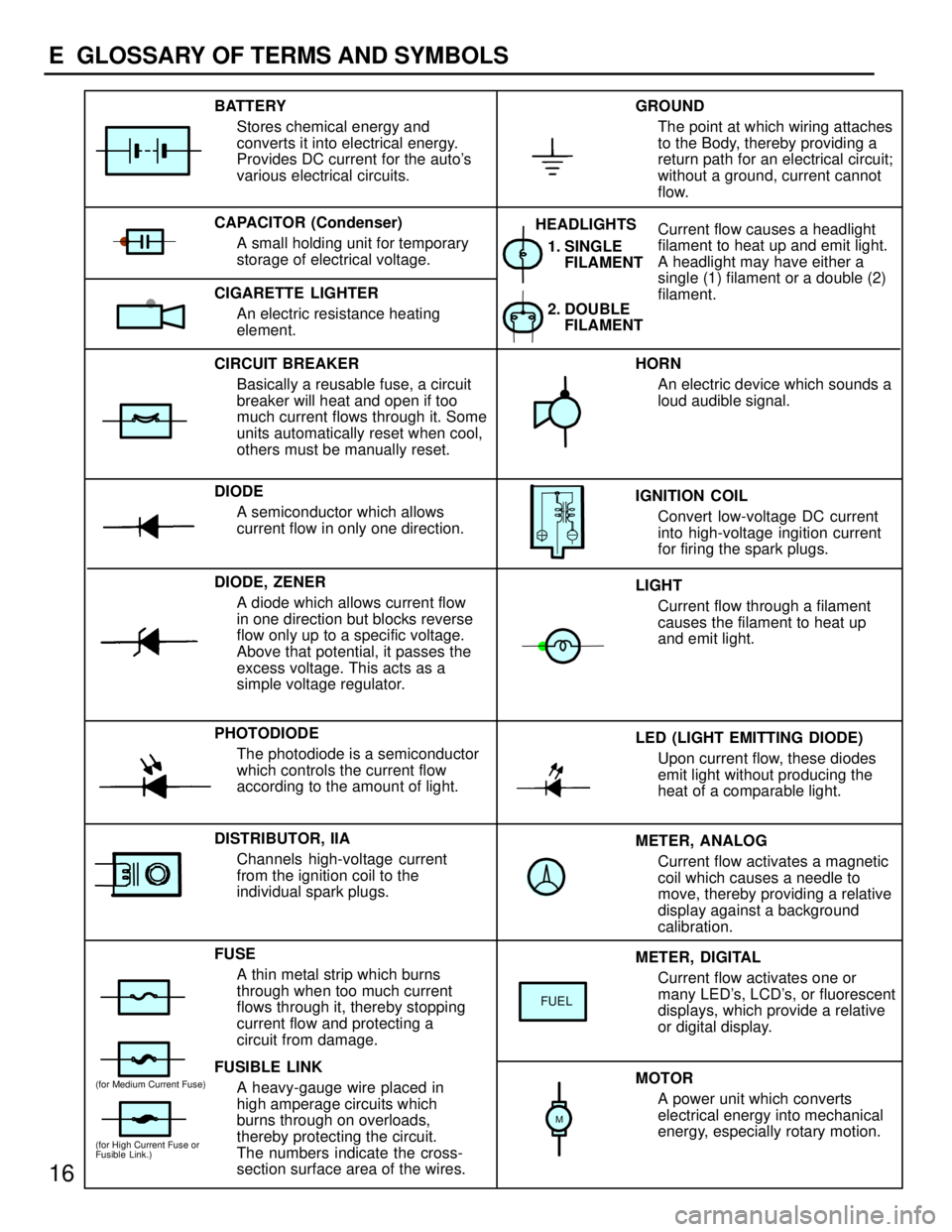Page 780 of 1354

10
C TROUBLESHOOTING
VOLTAGE CHECK
(a) Establish conditions in which voltage is present at the
check point.
Example:
- Ignition SW on
- Ignition SW and SW 1 on
- Ignition SW, SW 1 and Relay on (SW2 off)
(b) Using a voltmeter, connect the negative lead to a good
ground point or negative battery terminal, and the
positive lead to the connector or component terminal.
This check can be done with a test light instead of a
voltmeter.
CONTINUITY AND RESISTANCE CHECK
(a) Disconnect the battery terminal or wire so there is no
voltage between the check points.
(b) Contact the two leads of an ohmmeter to each of the
check points.
If the circuit has diodes, reverse the two leads and check
again.
When contacting the negative lead to the diode positive side
and the positive lead to the negative side, there should be
continuity.
When contacting the two leads in reverse, there should be no
continuity.
(c) Use the volt/ohmmeter with high impedance (10 kW/V
minimum) for troubleshooting of the electrical circuit.
Page 786 of 1354

METER, ANALOG
Current flow activates a magnetic
coil which causes a needle to
move, thereby providing a relative
display against a background
calibration. LED (LIGHT EMITTING DIODE)
Upon current flow, these diodes
emit light without producing the
heat of a comparable light. IGNITION COIL
Convert low-voltage DC current
into high-voltage ingition current
for firing the spark plugs. 1. SINGLE
FILAMENT
GROUND
The point at which wiring attaches
to the Body, thereby providing a
return path for an electrical circuit;
without a ground, current cannot
flow.
Current flow causes a headlight
filament to heat up and emit light.
A headlight may have either a
single (1) filament or a double (2)
filament. BATTERY
Stores chemical energy and
converts it into electrical energy.
Provides DC current for the auto's
various electrical circuits.
CAPACITOR (Condenser)
A small holding unit for temporary
storage of electrical voltage.
CIRCUIT BREAKER
Basically a reusable fuse, a circuit
breaker will heat and open if too
much current flows through it. Some
units automatically reset when cool,
others must be manually reset.
DIODE
A semiconductor which allows
current flow in only one direction.
DIODE, ZENER
A diode which allows current flow
in one direction but blocks reverse
flow only up to a specific voltage.
Above that potential, it passes the
excess voltage. This acts as a
simple voltage regulator.
PHOTODIODE
The photodiode is a semiconductor
which controls the current flow
according to the amount of light.
FUSE
A thin metal strip which burns
through when too much current
flows through it, thereby stopping
current flow and protecting a
circuit from damage.
FUSIBLE LINK
A heavy-gauge wire placed in
high amperage circuits which
burns through on overloads,
thereby protecting the circuit.
The numbers indicate the cross-
section surface area of the wires.HORN
An electric device which sounds a
loud audible signal.
LIGHT
Current flow through a filament
causes the filament to heat up
and emit light.
METER, DIGITAL
Current flow activates one or
many LED's, LCD's, or fluorescent
displays, which provide a relative
or digital display.
MOTOR
A power unit which converts
electrical energy into mechanical
energy, especially rotary motion. CIGARETTE LIGHTER
An electric resistance heating
element.
DISTRIBUTOR, IIA
Channels high-voltage current
from the ignition coil to the
individual spark plugs.2. DOUBLE
FILAMENT HEADLIGHTS
FUEL
(for High Current Fuse or
Fusible Link.)
(for Medium Current Fuse)
M
16
E GLOSSARY OF TERMS AND SYMBOLS
Page 795 of 1354
25
F
6: R/B No. 6Engine Compartment Left (See Page 18)
Fusible Link BlockNear The Battery (See Page 18)
Page 814 of 1354
44
H POWER SOURCE (Current Flow Chart)
The chart below shows the route by which current flows from the battery to each electrical source (Fusible Link,
Circuit Breaker, Fuse, etc.) and other parts.
The next page and following pages show the parts to which each electrical source outputs current.
* These are the page numbers of the first page on which
the related system is shown.
The part indicated is located somewhere in the system,
not necessarily on the page indicated here.
[LOCATION]�: J/B No. 1 (See page 20)�: J/B No. 4 (See page 23)
�: R/B No. 6 (See page 25)�: Fusible Link Block (F7 on See page 28)
Page 823 of 1354
54
POWER SOURCE
8
22
35
44 1
2
22
2
22
I 3EA1 7
IG 1 11
I 3
EA21
13
17
15
19 3 0A M AIN NO . 1 22
2
2
2
2 TO GENERATO R
A AW
R-W
W
L- Y
L- R W W W-B
W W-B
B-R B-R B-R
B-R
L-R
B-Y
B
W
W W WW-B
W-BW-R
L- R
B W W
60A ABS
B-YE/G M AIN
RELAY30A CDS FAN
30A RDI FAN
JUNCTION
CONNECTOR J 1I1 020A AM 2
5A ALT- S
15A E FI
15A HAZ-HORN
15A D O M E
W
WL-R
B-Y
B
B-W
F 7
720
5
12
16
18 146
122
3
B-R BATTERY
FUSIBLE LINK BLOCK65 24
80A M AIN
100A ALT
50A H TR
54
4A2HEATER RELAY
7. 5A A/C 13
22 1
2
73
4
6
8 AM 2 AM 1ACC
IG 1
IG 2
ST2 IG N ITIO N S W
40A AM 11D9
1K4
2 1
Page 829 of 1354
60
IGNITION
IG 1 11
IG 1 4
20A
AM2
2 2
A
ECJ 2
JUNC
CON21 4 EA1 7
B-R B-R B-R
B-Y B- O
B-W W
B
L- YG
B- W B-O B
B-O
DISTRIBUTOR
BATTERYIGNITION
COIL
BR
B
A 2A1 G- G+ B1
B2 IGNITION COIL AND DISTRIBUTORB I 3 , I 4
A
20 21
2
E
OCK
A
B-O
I 5
W
I 4
(
SHIELDED)
(
SHIELDED)
AIG 2 8
4
NCTION
ONNECTOR
B TO TA C H
[C O M B .
TO A/C AM PRIFIER
1 2
CRANKSH
POSITION
SENSOR C 2
R
1D 8
1H 14
CB
IG T IGF EXT 53
IG N ITER I 2
AFT
TIO N
NECTORNE- IGT IGF
E 4
ENGINE CONTROL
MODULEG+ NE+
R
417 5 20 3J
BB
OM ETER
METER]G
IG NITION S W I1 0 AM1ACC
IG 1
76AM2 IG2
ST2
80A M AIN
FUSIBL
LINK BL F 7
U
DJ
C
DD
Page 831 of 1354
62
CHARGING
2
5A
ALT-S
2 12 13
IG1 2
IG 2 2EA1 1 9 FROM POWER SOURCE SYSTEM (
SEE PAGE 54)
WWR-LW
W
YW
R-L
B-O R-
B R-L
W
W ARNING
ETER]
BATTERYSIBLE
NK BLOCK
TO BACK-UP LIGHT SW
R-L R-L
I 5
Y
W
A C
B B JUNCTION
CONNECTORB J10 , J11A
10A
GAUGE7. 5A
IG N 310
411FUSE
BLOCK F 8
1E 8
1B 81E 1
1C 11
L
-O
8CHARGE
LIGHT
[CO M B. M C1 1
42
FU
LI
100A ALT
80A M AIN
F 7IG L S B
IC RE G U LA TO R
B G 1 , G 2A
GENERATORA 1 B 3 B 1 B 2
Page 833 of 1354

64
ENGINE CONTROL
THE ENGINE CONTROL SYSTEM UTILIZES A MICROCOMPUTER AND MAINTAINS OVERALL CONTROL OF THE ENGINE ETC. AN
OUTLINE OF ENGINE CONTROL IS GIVEN HERE.
1. INPUT SIGNALS
(1) ENGINE COOLANT TEMP. SENSOR SIGNAL SYSTEM
THE ENGINE COOLANT TEMP. SENSOR DETECTS THE ENGINE COOLANT TEMP. AND HAS A BUILT-IN THERMISTOR WITH A
RESISTANCE WHICH VARIES ACCORDING TO THE ENGINE COOLANT TEMP. THUS THE ENGINE COOLANT TEMP. IS INPUT IN
THE FORM OF A CONTROL SIGNAL TO TERMINAL THW OF THE ENGINE CONTROL MODULE.
(2) INTAKE AIR TEMP. SIGNAL SYSTEM
THE INTAKE AIR TEMP. SENSOR DETECTS THE INTAKE AIR TEMP. , WHICH IS INPUT AS A CONTROL SIGNAL TO TERMINAL THA
OF THE ENGINE CONTROL MODULE.
(3) OXYGEN SENSOR SIGNAL SYSTEM
THE OXYGEN SENSOR DETECTS THE OXYGEN DENSITY IN THE EXHAUST EMISSION WHICH IS INPUT AS A CONTROL SIGNAL
TO TERMINALS OX1 AND OX2 OF THE ENGINE CONTROL MODULE.
(4) THROTTLE SIGNAL SYSTEM
THE THROTTLE POSITION SENSOR DETECTS THE THROTTLE VALVE OPENING ANGLE, WHICH IS INPUT AS A CONTROL
SIGNAL TO TERMINAL VTA OF THE ENGINE CONTROL MODULE, OR WHEN THE VALVE IS FULLY CLOSED.
(5) VEHICLE SPEED CIRCUIT
THE VEHICLE SPEED IS DETECTED BY VEHICLE SPEED SENSOR INSTALLED IN THE TRANSMISSION AND THE SIGNAL IS INPUT
TO TERMINAL SPD OF THE ENGINE CONTROL MODULE VIA THE COMBINATION METER.
(6) PARK/NEUTRAL POSITION SW SIGNAL SYSTEM
THE PARK/NEUTRAL POSITION SW DETECTS WHETHER THE SHIFT POSITION IS IN NEUTRAL OR NOT, AND INPUTS A CONTROL
SIGNAL TO TERMINAL NSW OF THE ENGINE CONTROL MODULE.
(7) A/C SW SIGNAL SYSTEM
THE OPERATING VOLTAGE OF THE A/C MAGNETIC CLUTCH IS DETECTED AND INPUT IN THE FORM OF A CONTROL SIGNAL TO
TERMINAL ACI OF THE ENGINE CONTROL MODULE.
(8) BATTERY SIGNAL SYSTEM
VOLTAGE IS CONSTANTLY APPLIED TO TERMINAL BATT OF THE ENGINE CONTROL MODULE. WHEN THE IGNITION SW IS
TURNED TO ON, VOLTAGE FOR THE ENGINE CONTROL MODULE OPERATION IS APPLIED VIA THE EFI MAIN RELAY TO
TERMINAL +B OF THE ENGINE CONTROL MODULE.
(9) INTAKE AIR VOLUME SIGNAL SYSTEM
INTAKE AIR VOLUME IS DETECTED BY THE MANIFOLD ABSOLUTE PRESSURE SENSOR AND IS INPUT AS A CONTROL SIGNAL
TO TERMINAL PIN OF THE ENGINE CONTROL MODULE.
(10) STARTER SIGNAL SYSTEM
TO CONFIRM THAT THE ENGINE IS CRANKING, THE VOLTAGE APPLIED TO THE STARTER MOTOR DURING CRANKING IS
DETECTED AND IS INPUT AS A CONTROL SIGNAL TO TERMINAL STA OF THE ENGINE CONTROL MODULE.
(11) ELECTRICAL LOAD SIGNAL SYSTEM
THE SIGNAL WHEN SYSTEMS SUCH AS THE REAR WINDOW DEFOGGER, HEADLIGHT, ETC. WHICH CAUSE A HIGH ELECTRICAL
BURDEN ARE ON IS INPUT TO TERMINAL ELS AS A CONTROL SIGNAL.
SYSTEM OUTLINE